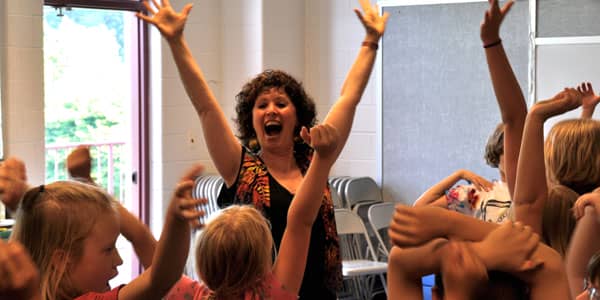Blog

Meet our new artists: Noa Baum

During the last two years, our roster has grown in size to encompass new artists, ensembles, and art forms. From slam poets to improvisers to Capoeira masters, these new artists are undeniably unique.
To introduce audiences to our new artists, we’ll be posting interviews with those who recently joined our roster, giving them a chance to share more about themselves and their experiences with Young Audiences so far.
Israeli-born Noa Baum, who joined the Young Audiences roster in 2013, is an internationally acclaimed storyteller who uses mesmerizing voices, impeccable timing, and warm authenticity to captivate audiences and confront important topics. Read on to learn how she got involved in storytelling and why she believes it’s so essential.
What is your background as an artist?
I was an actress in Israel at the Khan Theatre, a repertory theatre in Jerusalem. I studied acting at Tel Aviv University, studied with Uta Hagan, and received my Master’s from New York University in Educational Theatre. I started as an actress, but I wanted more. There’s actually a story about why I became a storyteller: I didn’t get an acting part I wanted, so to make ends meet, I got a job doing a story hour with kids in Tel Aviv. The way that the children reacted there was very powerful, and I wanted to learn more about the power of drama and story.
How did you hear about Young Audiences?
I moved to the east coast after living in Israel, and I’ve worked in the area ever since. I heard about Young Audiences when I arrived, and I auditioned and was accepted onto the roster.
What made you decide to become a Young Audiences roster artist?
I really like what Young Audiences does for artists. As an artist, it’s hard to market yourself to the schools by yourself. Working in schools is only part of what I do—I do programs for adults as well—so I wanted someone to take care of the marketing for me because it’s a lot of work. Young Audiences is very dedicated. It’s a lot of really good people working and keeping ongoing relationships with the schools and the school districts.
Have you had any programs through Young Audiences yet? What was the most memorable part?
I’ve been really grateful for this year because, as a first year artist, I’ve gotten to work with a lot of schools. The most memorable part has been the flexibility and support of the staff. With Young Audiences, I feel that I have a home and people to support me. As an artist, it feels really good to know that I can focus on my art because I have people taking care of the logistics.
Why do you believe art is important for every student to have access to?
I think art offers a holistic engagement of the brain, the heart, the body, and the whole self. As humans, art is the way we make meaning of who we are, why we’re here, and what this world is made of. Art has never been separate in the development of humanity, but unfortunately, we live in a society where we’ve started separating it. Art has become this extra thing, something that can be cut from the budget because it’s not as important. I don’t think it’s something extra. I don’t even think art is a subject as much as it’s a way of being. The more we integrate the arts into the subjects that we teach, the more we help the students learn and become who they are.
What does your art form in particular teach students?
Our brain processes information through stories. It’s how we remember and how we learn. Storytelling is the best teaching tool that I know—all of the great teachers and leaders of the world have been great storytellers. For me, storytelling teaches a lot of things, the most important being connecting with yourself. It’s an art form that asks you to participate and connect with your creative life force.
I think another amazing and powerful thing that storytelling teaches is listening in a deep, authentic, and fun way. From a very young age, we tell children to be quiet and listen. We expect them to be obedient and listen to instructions, but we don’t offer practice that teaches them how. One of the best ways to teach how to listen is to create an experience where listening is supported, such as a storytelling performance. Storytelling helps cultivate listening because you really have to listen to be able to imagine.
Storytelling works on a cognitive level as well. There’s a lot of research showing that if you want kids to be good writers, they have to be exposed to a lot of oral language. Writing and reading are basically connecting signs to things in your brain. The more words you’ve been exposed to orally and the richer the language you have in your head, the faster you can connect it to words on paper. If you’re looking at words and you don’t know what they mean or have no experience with them, reading and writing will always be a struggle. But if you know what “blossom” means, for example, and if you’ve heard it many times, you can connect the letters to the meaning faster.
Storytelling helps us emotionally connect the mind and heart. You may not remember all the intricacies of a story, but you’ll remember how you felt when you heard it, and sometimes, that can be lifesaving.
Learn more about the Noa’s offerings through Young Audiences here.
Keep an eye out for more interviews featuring our newest roster artists! See past new artist interviews here.








